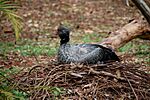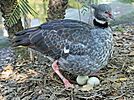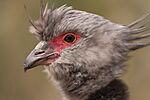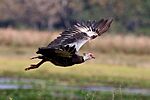Southern screamer facts for kids
Quick facts for kids Southern screamer |
|
|---|---|
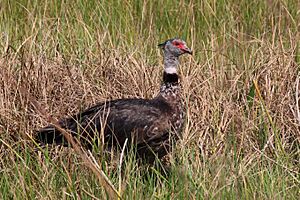 |
|
| in the Pantanal, Brazil | |
| Conservation status | |
| Scientific classification | |
| Genus: |
Chauna
|
| Species: |
torquata
|
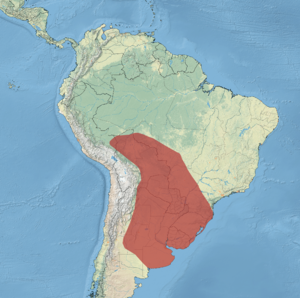 |
|
| Distribution map | |
The southern screamer (Chauna torquata) is a unique bird. It belongs to the Anhimidae family, which is part of the waterfowl group called Anseriformes. You can find this bird in several South American countries. These include Argentina, Bolivia, Brazil, Paraguay, Peru, and Uruguay.
Contents
Meet the Southern Screamer: What Kind of Bird Is It?
The southern screamer is related to two other birds. It shares its group, called Chauna, with the northern screamer. There is also another bird in the same family, the horned screamer. This shows how the southern screamer fits into the bird family tree.
Physical Features: What Does a Southern Screamer Look Like?
The southern screamer is a large bird. It is one of the biggest birds in southern South America. It grows to be about 83 to 90 centimeters (33 to 35 inches) long. It weighs around 4.4 kilograms (9.7 pounds). Its body is strong, but its head is quite small. It has a grayish-brown beak that looks a bit like a chicken's.
Both male and female southern screamers look the same. Their head and upper body are gray. They have a dark, velvety "collar" around their neck. Their wings and tail are dark. Each wing has two sharp spurs, like small spikes. The front of their neck and chest are pale gray with some white marks. Their belly is light gray or white. Their legs and feet are a pretty rosy color.
Where Do Southern Screamers Live?
Southern screamers live in the eastern part of Bolivia. Their home stretches south into Argentina, reaching as far as Buenos Aires. They also live east through Paraguay into southwestern Brazil and Uruguay. Sometimes, they are seen in southeastern Peru, but this is rare.
These birds love tropical and subtropical wetlands. This means they live in places like lakes, marshes, and flooded meadows. They often choose areas with scattered trees.
Behavior: How Do Southern Screamers Act?
Movement and Travel Habits
Southern screamers usually stay in one place. They do not migrate long distances. However, some birds in Brazil's Rio Grande do Sul seem to move. They travel between coastal and inland areas depending on the season.
How They Get Around
Southern screamers are good swimmers. But they prefer to walk on the ground. They are also excellent flyers. They can soar high in the sky, using air currents to glide.
What Do Southern Screamers Eat?
Southern screamers mostly eat plants. They feed on leaves, stems, and seeds of water plants. They also eat some farm crops. They often graze like geese, eating grass and other plants. Sometimes, they dig in the ground to find food. When it's not breeding season, groups of up to 100 birds may search for food together.
Reproduction: The Life Cycle of Southern Screamers
Southern screamers form strong pair bonds. These pairs often stay together for their whole lives. Males and females show affection by preening each other's feathers. They also call out together in a special duet.
They build a large nest using sticks and reeds. The nest is usually near shallow water. They often use the same nesting spot for many years. A female typically lays three to five eggs. Sometimes, she can lay up to seven eggs. Eggs are laid in October and November. Both parents take turns sitting on the eggs. They also care for the young birds. The eggs hatch after 43 to 46 days. The young birds can fly after eight to ten weeks. They become independent after about 12 weeks.
Vocalization: The Screamer's Call
The southern screamer is known for its loud call. It's described as a "loud, unmelodious, double-noted trumpet call." Some say it sounds like a low, throaty "oh-WOOOW" or "be-SERK." Female calls are a bit softer and higher pitched than male calls. Screamers call both when flying and when sitting. Their call can be heard from up to 3 kilometers (1.9 miles) away.
Domestication: Screamers as Guard Animals
People sometimes keep southern screamers as pets. They are very good guard animals. This is because of their loud call, which can be heard from far away. They will alert their owners to anything unusual.
Conservation Status: Are Southern Screamers Safe?
The IUCN (International Union for Conservation of Nature) says the southern screamer is of "Least Concern." This means they are not currently in danger. They live across a very large area. Even though their exact numbers are not known, their population seems to be stable. No immediate threats have been found. Draining wetlands and farmers bothering them could be problems. But the birds seem to be able to handle these issues quite well.
Gallery
-
At Artis Zoo, Netherlands



